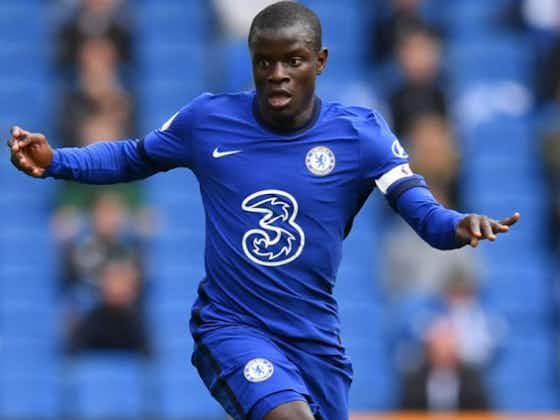Tribal Football
·23 November 2020
Talking Tactics: How Lampard has used Kante to transform Chelsea

Tribal Football
·23 November 2020

The unique challenges of playing football during a pandemic have simplified the Premier League. The decrease in time for tactical coaching between matches, coupled with the drop of pressing intensity as fatigue sets in, has simplified English football and seen what appears to be a regression to the early 2010s – when the division lacked the detail and sophistication of modern times.
Back then, before Antonio Conte, Pep Guardiola and Jurgen Klopp introduced us to automatisms and pressing traps, to hyper-choreographed phases of play both on and off the ball, Premier League managers could rely on their players to problem solve. The manager's job was to implement a broad strategy, but the landscape was simple enough that individuals trumped systems.
Manuel Pellegrini's title-winning Manchester City team is a good example, a vaguely attacking team without obvious set-plays or even a distinctive style of play, but with good-enough players to function in a relatively simplistic 4-2-3-1.
CHELSEA BENEFIT FROM LOCKDOWN LAWS
The pandemic has seen us return to those days, and it looks as though Frank Lampard – a player still in his prime in the early 2010s – stands to benefit more than most. Last season his lack of tactical detail, his preference for creative freedom with only broad strategic strokes applied from the dugout, looked too out-dated to be successful. But the simplicity of the sport through 2020 means little 'Football Manager' style changes of personnel can have a dramatic impact.
And so, where his enormous problem with the defensive transition seemed too systemic to be solved (Chelsea are decompressed between the lines, and move too far out of shape when on the ball), now Lampard appears to have patched things up simply by moving N'Golo Kante into a defensive midfield position.
The change has given Chelsea the defensive cover they need in the middle of the park to help sweep up behind the attackers, cutting off opposition counter-attacks before they get started.
KANTE'S POSITIONAL HISTORY
Mainstream analysis of Kante's positional play over the last few games has broadly suggested the Frenchman has 'returned' to his defensive midfield role. In reality, Kante has virtually no experience of playing alone at the base of midfield.
Before a run of games in defensive midfield towards the end of last season, Kante has always functioned as part of a two. He had Danny Drinkwater alongside him in a two-man midfield at Leicester City and Nemanja Matic in a similar midfield shape under Antonio Conte at Chelsea.
Kante did feature as a defensive midfielder, behind two more advanced centre-mids, for four games at the start of Conte's reign in a 4-1-4-1, but in two of these games the Italian switched formations at half-time. By September, he found a way to shift to a 3-4-2-1 and Chelsea's season took off.
Aside from that brief spell, and a couple of games for France at the beginning of the World Cup before Didier Deschamps switched to a 4-2-3-1, Kante has never been placed in the Claude Makelele role. It is a startling misconception; Kante has never been a purely defensive player.
KANTE'S CONVERSION UNDER LAMPARD
Starting with a game against Aston Villa in June, Kante's first appearance in the centre of a three-man midfield since a rogue Nations League match in October 2018, Chelsea's number seven has started 17 matches in all competitions for Chelsea and appeared as the lone defensive midfielder on eight occasions, notably doing so in each of their last three Premier League matches.
Chelsea have won seven of those eight games, falling to a 3-2 defeat to West Ham United in July. More tellingly, Kante has been excellent in his last three, averaging 11 ball recoveries per game as Chelsea conceded just once against Newcastle United, Sheffield United, and Burnley.
These are particularly easy matches, of course, and for now the sample size is too small, but Chelsea have looked more secure with someone of Kante's instinct for danger lurking in the centre circle, protecting his team's attacks. Lampard's side have certainly looked stronger than in the 3-3 draws with Southampton and West Brom, in which Kante roamed forward on the right side of a three.
CHELSEA'S SEASON TRANSFORMED
The coming months promise to be erratic for every Premier League club. The fixture pile-up and lack of time for midweek coaching should see matches drop in intensity and become more simplistic tactical affairs. It should also mean that nobody will put together significant winning streaks, potentially lowering the title-winning points tally to somewhere in the mid-80s.
That seems achievable for Chelsea given their incredible depth of attacking talent. The Newcastle win on Saturday was the perfect of example of what this retrograde Chelsea can do: flat-track bully the majority of the division through sheer individual talent.
Lampard might not be the most sophisticated manager, but right now he doesn't need to be – and the simple act of converting Kante into a defensive midfielder has plugged a significant hole in the Chelsea midfield.
It won't have entirely solved their problems defending counter-attacks, but it doesn't have to. Chelsea can afford to lose quite a few games and still lift the title. With players like Kante filling the gaps, they stand a genuine chance.


Live





























































